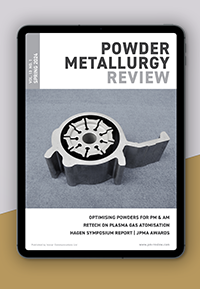CMI Hub project takes key step to process rare earth metals in US
October 18, 2023

The Critical Materials Innovation Hub (CMI Hub), a US Department of Energy Innovation Hub led by the US Department of Energy’s Ames National Laboratory and supported by the Office of Energy Efficiency and Renewable Energy’s Advanced Materials and Manufacturing Technologies Office (AMMTO), reports it has worked with industry to take a key step in how to process rare earth metals in the United States.
The capability to produce these metals will help the US create a supply chain for neodymium iron boron permanent magnets.
For the past two years, the CMI Hub Open Innovation Projects (OIP) brought together Terves LLC and Powdermet Inc, both based in Euclid, Ohio; Worcester Polytechnic Institute (WPI), Massachusetts; and Ames National Laboratory to produce and refine rare earth metals.
“OIP projects are led by industry to help the next generation of CMI Hub research and development align with industry needs. This project helps enable a domestic supply of rare earth metals for strong permanent magnets,” stated Thomas Lograsso, CMI Hub Director, Ames National Laboratory. “These metals are used in multiple industries. They had relied on midstream processing overseas. Through this work, we made ways to bring that to the United States.”
Andrew Sherman, Terves Chief Executive Officer, served as project lead. The research group started in spring 2021. Their two-year goal focused on using heat and metal to make high purity neodymium, necessary to enable a US supply chain for neodymium iron boron permanent magnets. The key was creating low-temperature, scalable processes using the Terves foundry to speed up the establishment of rare earth metal manufacturing in the United States.
Terves worked with the Materials Preparation Center (MPC) at Ames National Laboratory on purification. MPC is a specialised research centre recognised for its unique capabilities in purification, preparation and characterisation of rare earths, metals, alloys, and single crystals.
Matt Besser, MPC director, says capabilities within the MPC were repurposed. High-purity calcium metal is usually added to rare earth fluorides to reduce into rare earth metals. High-purity calcium is made by MPC using vacuum distillation where calcium is vaporised and collected, leaving behind impurities that are detrimental in reduction processing. Here, they used the same process to separate volatiles like magnesium and calcium from neodymium from the rare earth metal that was reduced by Terves.
“The desired metals are left behind and the rest can be reused in the process,” Besser said. “We used arc melting to remove other unwanted bits. This left us with pure rare earth metals.”
Sherman noted that the team’s success meets the goal to refine neodymium at a small scale and increase to pilot scale. They worked with MPC to produce high purity neodymium. And, they showed how to make a new metal from recycled raw materials for making magnets. This made a mixed metal of neodymium, praseodymium and dysprosium, which theoretically can be used directly in the production of neodymium iron boron permanent magnets.
WPI made models that helped refine the process. The Terves team then used the models to refine metal and salt compositions at lower processing temperatures. This paves the way to use less energy and lower the cost of supplies. The team also worked with Purdue University who developed a techno-economic analysis and a pricing model.
Download PM Review magazine















